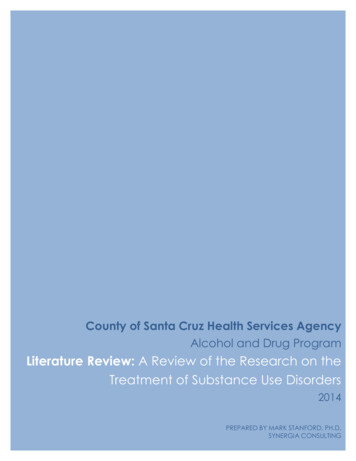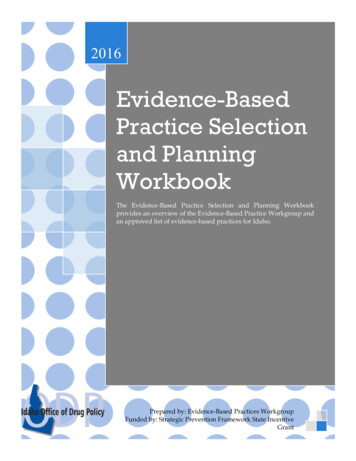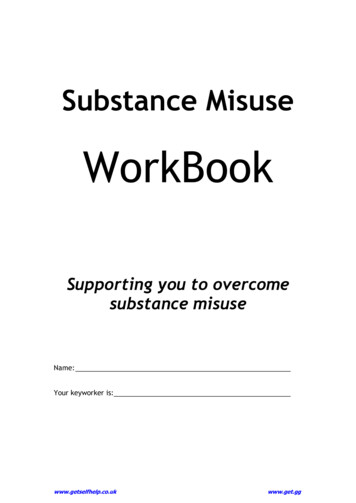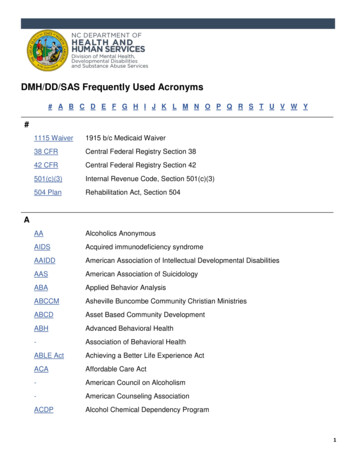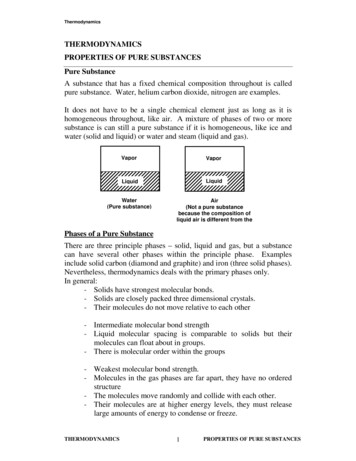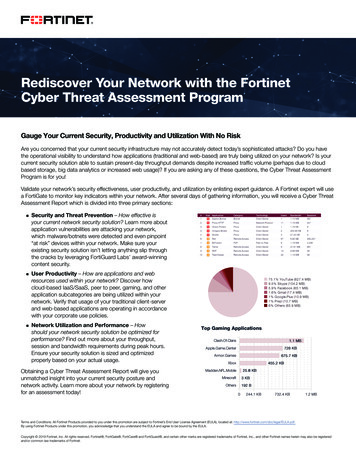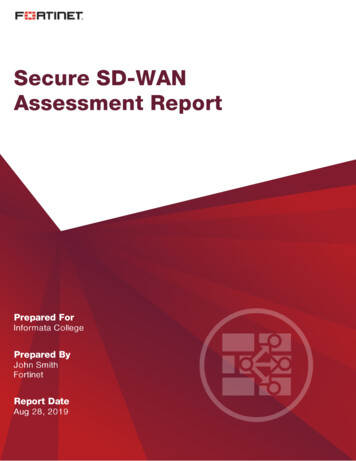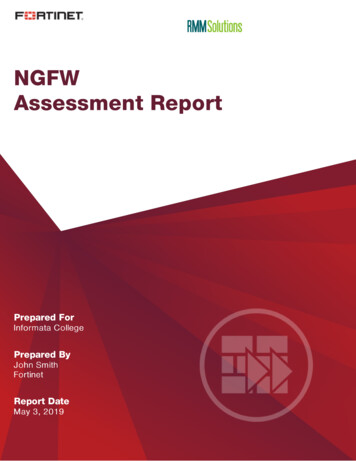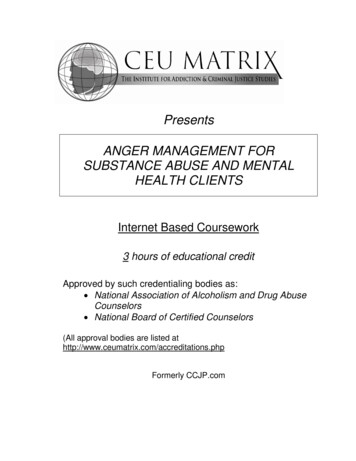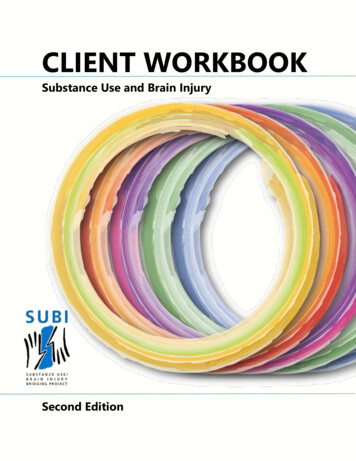
Transcription
CLIENT WORKBOOKSubstance Use and Brain InjurySecond Edition
SUBI Project Team First Edition (2007)Community Head Injury Resource Services of Toronto (CHIRS):Carolyn Lemsky, PhD, CPsych, ABPP/ABCN, Clinical DirectorIrene Sullivan, Hon BA, Dip CS, Project CoordinatorPam Kaufman, SSW, Substance Use Community FacilitatorKristen Caballaro, Hon BA, Service CoordinatorCenter for Addiction and Mental Health (CAMH):Dennis James, MSc, Deputy Clinical Director, Addictions ProgramJerry Schwlab, RSSW, Manager, Addiction Assessment & Day/Residential Treatment ServicesTim Godden, MSW, RSW, Advanced Practice ClinicianToronto Acquired Brain Injury Network:Charissa Levy, MHSc, BScOT, Executive DirectorJudy Moir, MPA, BA Psych (Hons), Assistant Executive DirectorHeather Brien, MBA, BScOT, Executive DirectorWriting: Heather Chisvin, heather@chisvin.comDesign: David Wyman, www.wymandesign.caIllustration: Kathryn Adams, www.kathrynadams.comSUBI Project Team Second Edition (2021)Community Head Injury Resource Services of Toronto:Carolyn Lemsky, PhD, CPsych, ABPP/ABCN, Clinical DirectorCenter for Addiction and Mental Health:Tim Godden, MSW, RSW, Advanced Practice ClinicianNational Association of State Head Injury Administrators (NASHIA):Maria Crowley, MA, CRC-Consultation, Editing, and DesignAcknowledgementsWe would like to thank the staff and clients in the Neurobehavioral Treatment Program (NBIP)at CHIRS for adding their invaluable experience to inform updates to the second edition of thisworkbook. We would also like to acknowledge the contributions of Sandi Boucher, Consultant,who provided extensive feedback on how to make the second edition of the workbook moreinclusive and sensitive to indigenous culture. The materials from the original workbook werebased upon the programming provided at CAMH, Brentcliffe Site. The updated information isbased upon the clinical experience of the second edition main authors, as well as consultantsMaria Crowley, NASHIA, and Leslie Buckley, Addiction Psychiatrist and Chief of AddictionsDivision, CAMH. The Mid-America and Mountain Plains Addiction Technology Transfer Centers(ATTCs) partnered with NASHIA to produce two companion documents to this workbook: thetoolkit entitled, Traumatic Brain Injury and Substance Use Disorders: Making the Connectionsand a Provider Tip Card. The ATTCs are funded by Substance Abuse and Mental Health ServicesAdministration grants #1H79TI080208 and #5UR1T1080200.Funding provided in part byAlabama Department of Rehabilitation Services, Brain Injury Association of New Hampshire,Massachusetts Rehabilitation Commission, Ohio Brain Injury Program, Virginia Department ofAging and Rehabilitative Services.SUBI Client Workbook2
Table of ContentsForeword to the Second Edition . 6Introduction . 7How to Use this Workbook . 8Introduction to Substance Use and Brain Injury . 9Part 1: Is My Substance Use Something to Worry About? . 12Chapter 1: Building a Support Network . 13Check-In: Who Is in Your Life Right Now?. 14Worksheet: Building a Support Network . 15Chapter 2: What Everyone Needs to Know About the Effects of Substance Use . 16Chapter 3: How Satisfied Are You with Your Life Right Now?. 24Check-In: Your Level of Satisfaction . 24Chapter 4: How Will I Know When It Is Time to Act on Substance Use?. 26Worksheet: How Will I Know It Is Time?. 27Chapter 5: A Letter to My Future Self . 30Part 2: Tackling My Substance Use . 32Chapter 6: Goal Setting for Substance Use . 33Worksheet: Daily Diary . 39My Early Recovery Plan . 40Chapter 7: First Things First. Ideas for Getting Started . 43Plan: Getting Started with Your Goals . 44Chapter 8: Saying No to Alcohol and Drugs . 47Worksheet: Planning Ahead. 48Chapter 9: Coping with Cravings . 50Check-In: Stop and Think About Cravings . 51Chapter 10: Being in Groups . 52Worksheet: Being in Groups . 55Part 3: Coping Strategies for Life. 60Chapter 11: Making the Most of Your Brain Power . 61SUBI Client Workbook3
Worksheet: What Are My Strengths and Challenges? . 62Chapter 12: Assertiveness . 68Check-In: Basic Coping Styles . 69Worksheet: Assertiveness . 71Chapter 13: Dealing with Boredom . 74Check-In: What Keeps You from Making Good Use of Your Time? . 75Worksheet: Dealing with Boredom . 76Chapter 14: Coping with Strong Feelings . 78Worksheet: Coping with Strong Feelings . 81Chapter 15: Journaling. 83Worksheet: Daily Journal. 85Part 4: Skills for Maintaining Your Health and Relationships . 86Chapter 16: Mindfulness . 87Check-In: How Do You Know When You Are Stuck in Your Thoughts or Feeling Tense? . 88Worksheet: Relaxing Your Mind . 92Chapter 17: Problem Solving . 93Worksheet: Problem Solving . 97Chapter 18: Staying Healthy . 99Worksheet: Staying Healthy . 105Chapter 19: Being Your Own Best Friend . 106Worksheet: Being Your Own Best Friend . 107Check-In: Being Your Own Best Friend Takes Practice. . 108Chapter 20: Building Self-Esteem . 109Check-In: Start a Conversation . 110Worksheet: Building Self-Esteem . 112Chapter 21: Building Healthy Relationships . 114Check-In: What Do You Do to Keep Healthy Boundaries?. 116Worksheet: Building Healthy Relationships . 117SUBI Client Workbook4
Part 5: Pulling It All Together .119Chapter 22: Learning from Setbacks . 120Check-In: Am I At Risk for a Setback? . 121Chapter 23: Finding Sources of Hope and Inspiration . 123Closing Words of Encouragement . 130Appendix: Additional Resources .131SUBI Client Workbook5
Foreword to the Second EditionWe know from our experience and from research that problems with substance use andbrain injury often go together. However, brain injury rehabilitation programs andservices to address substance use are often in separate places, creating a gap in services.This workbook was originally created to help people living with brain injury and thosewho work with them to bridge that gap.We also know that people heal best from brain injury when they avoid the use ofalcohol and other non-prescribed drugs. While that is the best advice we can offer,decisions about substance use rest with the person who uses them. Reducing harm thatcomes with substance use is very important, whether it is the first or the only step takenin the journey to better health.Much of the content from the original SUBI workbook is retained. The overall structurehas been modified to better accommodate people who may not be ready to commit tochange in their substance use behavior in the short term. Our goal is to make all of theinformation about the effects of substance use available to everyone. It does not matterhow someone is currently feeling about their own substance use. No one should feelexcluded from this conversation, nor should they feel pressure to do something they arenot ready to do.SUBI Client Workbook6
IntroductionThis workbook was created for people who are living with the effects of a brain injuryand are wondering how their substance use may be affecting them.The original workbook and the second edition were designed by a partnership of peopleat Community Head Injury Resource Services of Toronto (CHIRS) and the Centre forAddiction and Mental Health (CAMH). To get the most out of this workbook we stronglyrecommend that clients review it with a trusted person who is familiar with addictionsand/or is helping people after brain injury.If you do not have a particular expertise in the area of brain injury or substance usedisorders, you are strongly encouraged to get consultation from a professional who canprovide support and guidance.This workbook is designed to be a resource for these groups:o People living with the effects of brain injury who thinking about the effects ofsubstance use on their quality of life and health. The multiple choice and checklistformat of check-ins is designed to facilitate self-reflection for people whosecognitive difficulties make answering open-ended questions difficult.o Providers with little experience in substance use should find enough informationand examples in each chapter to have meaningful conversations with their clientsabout substance use and its effects. However, the workbook is not intended to bea replacement for consultation with substance use professionals.o Providers with little experience in acquired brain injury should find that thestructured, written presentation and concrete examples will help clients tocompensate for memory impairments and other cognitive difficulties. However,consultation with an acquired brain injury provider is strongly recommended. Agood place to start is with your state or local brain injury program.SUBI Client Workbook7
How to Use This WorkbookThis workbook can be used to start a conversation about substance use or for handoutsin group settings. Each chapter is organized into the following sections to make theworkbook easy to follow:o Goalso Informationo Check-in (self-assessment)o Worksheeto Planning toolsTo make the content easy to understand, conversations using the workbook shouldbegin with a review of the goals, followed by the presentation of information, Check-in(self-assessment) and when appropriate, personal goal setting. In most chapters,information is brief enough that it can be reviewed in a single session. However, thereare some topic areas that are more complex and may take several sessions to review.The Check-ins are intended to encourage people to reflect on their own experiences.Worksheets and plans are provided to support the process of applying the newinformation and creating a plan of action that makes sense.The order of the chapters provides a logical sequence for the introduction ofinformation. This order can be altered to fit the needs of a particular client or thestructure of the program in which it is being used.Please note that not all chapters contain all sections. Worksheets can be taken out ofthe workbook and used as handouts for groups.SUBI Client Workbook8
Introduction to Substance Use and Brain InjuryIs my substance use really a problem?This is a hard question to answer, particularly for a person who has had a brain injury.We have reviewed available information about the effects of alcohol and brain injury.We have concluded that it is not safe to use alcohol in any amount after brain injury,even though safe use guidelines do exist.Unfortunately, there is relatively little information about the particular effects of othersubstances after brain injury. Safe use guidelines for cannabis are still being developedfor the general population. There are also no safe use guidelines for illegal substances.There is no clear agreement about how other substances, including cannabis, affectpeople after brain injury. We believe that a high degree of caution is needed.There are many reasons why it is considered unsafe to use illegal drugs. There is a risk ofgetting arrested. People who sell drugs are not regulated by law, so people who buythem are at risk for being the victims of crime. Some illegal drugs are a great risk forcausing further brain injury. Taking more of your prescription drugs than your doctorprescribes is also dangerous. Medical complications, including further brain injury, canhappen.We firmly believe that if you have had a brain injury, there are risks that come withdrinking alcohol in any amount. We also believe that it is not safe to use illegal drugs,and it is not safe to take more than the prescribed dose of your medications.These are signs that it might be time to ask for help. Do these apply to you?You have tried to cut back or stop using substances on your own but somehowyou keep on usingSomeone around you is very worried about your use of alcohol or drugsYou worry about your use of alcohol or drugsYou have had legal, financial, or relationship problems that are related to youruse of alcohol or drugsSUBI Client Workbook9
Eight reasons why many people choose to avoid substanceuse after brain injury. Your brain health and the ability to recover frombrain injury are probably very important to you. Here are the reasons that theOhio Valley Center gives for not using drugs or alcohol after a brain injury:1. People who use alcohol or other drugs after their injury do not recover as wellas those who do not. After brain injury some neurons (brain cells) are killed.Sometimes connections between neurons are disrupted as well. Recovery is theprocess of rebuilding connections between brain cells. Unfortunately, the bodycannot make new brain cells. Being intoxicated (drunk) means that functioning ofyour brain cells has been disrupted. This makes it more difficult to heal from your injury.2. Problems with balance, walking, and talking are made worse by alcohol anddrugs. Alcohol and drugs can cause falls and/or difficulty in speaking, even in thosewithout brain injury. After a brain injury, problems with balance and speech caused bythe injury itself can make these problems worse.3. People who have had a brain injury sometimes say and do things withoutthinking them through. This problem is made worse by drugs and alcohol. One ofthe functions of your brain is to stop you from acting on bad ideas. That function isturned off when you are using substances. This can result in doing and saying thingsthat you regret later.4. Brain injuries can make it more difficult to pay attention, remember newinformation, and think things through clearly. Drugs and alcohol interfere withall of these mental abilities. Many people find that after brain injury they have torelearn some of the skills they once had. It is common to have problems finding theright word, concentrating, solving problems, and making use of other thinking skills.Adding alcohol and drugs to these problems makes it even harder to get things done.5. After a person has had a brain injury, they generally find that alcohol and otherdrugs have a more powerful effect. After a brain injury, the brain is more sensitiveto alcohol and drugs. No matter what a person’s ability to handle alcohol and drugswas before their injury, it is reduced after injury. Alcohol and drugs can also interferewith any prescribed medications.SUBI Client Workbook10
6. After a brain injury it is common to have times when a person feels down ordepressed. Drinking and using drugs can make depression worse. After a braininjury there are a lot of changes and challenges that make life more difficult. That canbe a cause for feeling down. The effects of a brain injury itself can cause a depressedmood. That may be one reason why some people turn to alcohol or drugs to feelrelaxed and happier. That may be true in the short run. Eventually, things usually getworse. Alcohol acts as a depressant in the brain. That will make you more depressed.7. Drinking and using drugs can increase the likelihood of having a seizure. About5% of people with a brain injury go on to have trouble with seizures. Seizures areserious and can cause further brain damage or injury. That is why doctors take greatcare to help their patients prevent having seizures. Many people are prescribed drugsto prevent seizures after they have had a brain injury. It is very dangerous to mixalcohol and other drugs with these medications. Taking yourself off prescribed drugsso that you can drink is also very dangerous. Talk to your doctor and get the facts.8. Using drugs or alcohol after a brain injury increases your risk of having anotherbrain injury. After you have had one injury, your chances of having another braininjury are much greater. Brain injuries can cause people to have more accidentsbecause of changes in their balance, coordination, and judgment. Alcohol and drugsonly make these difficulties worse.Congratulations on deciding to seek more information on theeffect of substance use on acquired brain injury. Going throughthe information in this workbook will help you learn more aboutyour substance use. You will also find strategies to help youmanage difficulties that may happen during your recovery. You willfind information about how to pursue a healthy lifestyle.Remember that one book will not give you all the answers. It isimportant to find people who you trust to help you.SUBI Client Workbook11
Part 1: Is My Substance UseSomething to Worry About?There are different paths that lead a person to lookat the way they use alcohol and other drugs. Oneperson is curious how substance use might causeproblems. Another person may get advice from thedoctor about cutting back or stopping. Someoneelse may get a warning from a partner or family member that their relationship is introuble because of drugs or alcohol. Another person might have legal trouble becauseof something that happened while drunk or stoned.It does not matter why you are reading this book. We want you to know that thinkingabout your substance use is difficult but the rewards are big. This is true even if you donot decide to act right away. You – and those you trust – are in the best position todecide what you should do about your substance use and when the time is right to act.The first part of the workbook is to help you think about all the things connected tosubstance use that are happening in your life right now. The information and activitiesthat follow give you all the information you need to make informed choices about whatis best for you. The second part of the workbook gives you information and resourcesabout how to set a substance use goal. Getting organized will help you succeed inmeeting your goal. The third part includes tools that you can use to help you along yourpath.We believe that you deserve all the support that you can get, whatever path you choose.Our sincere belief is that no one really does anything big totally by themselves. The ideathat anyone can do it alone when tackling something important is a myth. It can be hardto know who you can and should depend on for support. That is why we will start withan exercise to help you build a team of people that can support you in making progresson whatever goals you choose to pursue – whether they are substance-use related orgeneral life goals. No matter what challenges you might be facing, the feedback andguidance from a trusted support network is important.SUBI Client WorkbookPart 1: Is My Substance Use Something to Worry About?12
Chapter 1: Building a Support NetworkTackling something big in your life may feel impossible if you try to do it alone. It canalso be hard to find the right people to help you along the way. Step one on anyimportant journey is figuring out who will be going with you.Here is an exercise to identify and further expand your support network.You might be feeling alone now because some of your relationships have changed.Often the people you see most are the ones who you spend time with to drink or usedrugs. They may be friendly, but they might not really think about what is best for you.Professionals like doctors or counselors who support you is a great start, but their timeis limited.That is why it is important to think about getting support from different places.What kinds of social support should you look for?EmotionalSomeone who will listen to you, that you can talk to about feelingsMoralSomeone who will encourage youPracticalSomeone you can ask for help with daily tasks, like transportationMentorshipSomeone you can look to for guidance and instructionRecreational Someone you can have fun withSUBI Client WorkbookPart 1: Is My Substance Use Something to Worry About?13
Check-In: Who Is in Your Life Right Now?By completing this exercise, you will get an idea of how everyone you know fitsinto your life. When you identify and label everyone, you will be able to see more clearlywho might best help you in your recovery.1. Write the names of people on the circle based on how often you see them.2. Circle the names of people who are now or could be supportive.3. Write an X by the names of people who are not supportive, or who might be harmful.4. Try to move the unhelpful people away from the center.5. Plan to move the helpful people closer.SUBI Client WorkbookPart 1: Is My Substance Use Something to Worry About?14
Worksheet: Building a Support NetworkComplete the sections below. Refer to the list above to helpyou think of your unmet support needs. For example, if you would like to start playingbaseball again and have no one to take you, write that down. Then think of someone whocould take you there and even play. Next, plan how you will contact that person. Look atthe circle on the previous page to get ideas of who you could contact and who you shouldnot contact.What do I need support with?Who can I ask?What is my plan?SUBI Client WorkbookPart 1: Is My Substance Use Something to Worry About?15
Chapter 2: What Everyone Needs to Know Aboutthe Effects of Substance UseOne thing to notice is that substance use can sometimes harm a person’s health. Tomake good decisions, it is important to have accurate information about the healtheffects of any substance you are using now. We suggest that you review the followinginformation with a highlighter and mark the details that are next to the substances youare currently using. After you do this, there is an exercise at the end of this chapter tohelp you summarize the most relevant information.Why it feels like you cannot live without drugs or alcoholOur brains make signals in a certain way. When we do something that gives uspleasure, we tend to want to do it again. That is what drives us to do things that helpus survive — like eating, for example. Drugs used to get high will change how thenatural chemicals work in the brain’s pleasure center. This change tricks you intothinking that the drug is something you need for survival. The changes in brainchemistry that drugs cause last much longer than the high experienced. That can causeserious long-term problems, includingwithdrawal symptoms and braindamage.This is a picture of the reward circuit inthe brain. The most important thing tonotice is that the reward circuit hasstrong connections to the part of yourbrain that is responsible for basicemotions (the nucleus accumbens) andthe part of your brain that regulatesReward Circuitbasic body functions (the ventral tegmental area). One of the reasons that addictivedrugs have such a strong effect is that they act on the part of the brain that overseesbasic survival instincts.SUBI Client WorkbookPart 1: Is My Substance Use Something to Worry About?16
In some ways drugs “highjack” our natural reward system. When the urge to use thedrug is strong enough, part of the brain can override the part that oversees reasoningand planning (pre-frontal cortex). Drugs can make the problem of being impulsive(acting without thinking) worse.This is also why people spend a lot of time and energy getting the drug they use for ashort-term high, even though it causes problems eventually. Some drugs have the effectof creating a strong urge to seek out the drug, even though the person using the drugmay be fully aware of the negative effects eventually.What do drugs and alcohol do to your body and your brain?Stimulants (like cocaine) speed up bodily functions. Depressants (like alcohol) slowdown body functions. Some substances change your thinking. This makes it harder totell the difference between reality, thoughts, and images that come from the brain itself.When we add chemicals to our bodies and brains, our bodies do their best to restoreour natural balance. This causes tolerance (needing more chemicals to get the effects ofthe drug). Often this results in less of the effect that is pleasurable (feeling energetic,confident, relaxed, or happy) and more sensitivity to the side effects (like anxiety, feelingparanoid, and having a pounding heart).What can be very confusing is that some drugs, particularly stimulants, create a strongurge or desire, which makes seeking the
SUBI Client Workbook . 8. How to Use This Workbook . This workbook can be used to start a conversation about substance use or for handouts in group settings. Each chapter is organized into the following sections to make the workbook easy to follow: o Goals o Information o Check-in (self-assessment) o Worksheet o Planning tools
